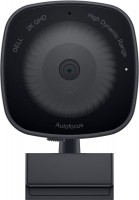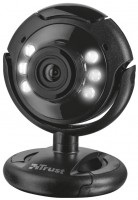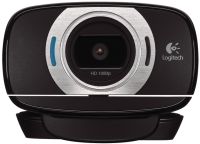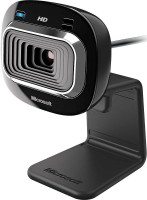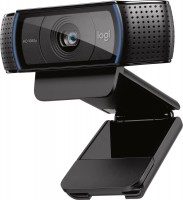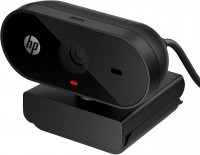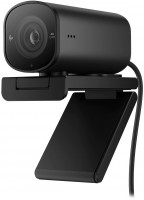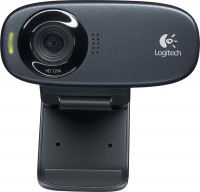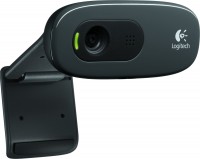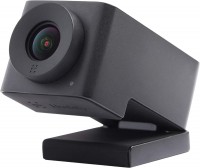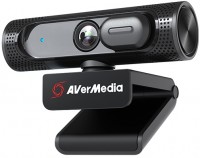Webcams Logitech
All Webcams Advanced filters → |
You might be interested in
Articles, reviews, useful tips
All materials
Useful gadgets for programmers that increase efficiency
USB hub, widescreen monitor, comfortable chair and other useful gadgets for coders and IT industry workers
Webcams: specifications, types
Features
The purpose of the webcam is indicated by the type of equipment for which it is designed.
— For a computer. The classic, most common variety — in fact, webcams as a type of technology were originally created specifically for use with a PC. Usually, they have compact dimensions and a mount for fixing on the monitor, although other design options are also found.
— For conferences. A separate subtype of cameras, which are more applicable for conference rooms or other large rooms, when more than one person should be present in the frame. Such models stand out for their large size and connect to a TV, they may have a remote control and other functions for use at a remote distance (specifically depends on the model).
— For a computer. The classic, most common variety — in fact, webcams as a type of technology were originally created specifically for use with a PC. Usually, they have compact dimensions and a mount for fixing on the monitor, although other design options are also found.
— For conferences. A separate subtype of cameras, which are more applicable for conference rooms or other large rooms, when more than one person should be present in the frame. Such models stand out for their large size and connect to a TV, they may have a remote control and other functions for use at a remote distance (specifically depends on the model).
Megapixels
The number of megapixels in the matrix that the camera is equipped with, in other words, the native resolution of the matrix. First of all, the maximum photo size directly depends on this indicator: for example, a 1600x1200 frame requires at least 1600 * 1200 = 1,920,000 pixels ≈ 2 MP. With video, the situation is somewhat different, where the actual resolution of the matrix can be noticeably higher than required for the frame.
There is an opinion that the more megapixels, the better the image is obtained. Formally, this is not the case: the resolution of the sensor only affects the detail, and in itself numerous megapixels can even worsen the picture — especially if the matrix is small. However, in fact, high-resolution sensors are often installed in fairly advanced cameras, in which high image quality is achieved through a number of characteristics.
There is an opinion that the more megapixels, the better the image is obtained. Formally, this is not the case: the resolution of the sensor only affects the detail, and in itself numerous megapixels can even worsen the picture — especially if the matrix is small. However, in fact, high-resolution sensors are often installed in fairly advanced cameras, in which high image quality is achieved through a number of characteristics.
WVGA filming (480p)
The maximum video resolution supported by the camera. WVGA is the most modest of the widely used formats — it does not belong to high-definition (HD) standards. Webcams of this format usually have a resolution of 640x480 to 1024x768; you should pay attention to them if you need the simplest and most inexpensive solution.
HD filming (720p)
Historically the first of the high definition HD (720p) standards. Initially, it assumed a resolution of 1280x720, however, in webcams, models with a different frame size are also included in this format — in particular, 960x720 and 1280x960, which have a 4:3 aspect ratio of the frame (unlike the original 1280x720, for which it is 16:9 ). Anyway, HD-models are relatively inexpensive and not particularly demanding on the quality of communication, however, they allow you to get a fairly detailed “picture”.
SXGA filming
A rather specific standard, assuming a resolution of 1280x1024, which gives a 5:4 aspect ratio of the frame. SXGA is a good option for cases where you need a frame with a standard (not widescreen) aspect ratio, and the corresponding options in HD resolutions are no longer enough.
Full HD filming (1080p)
Further, after HD 720p, the development of high definition standards. Provides a standard frame size of 1920x1080; in addition, this category includes webcams that support 1600x1200 video — this resolution does not formally apply to Full HD (1080p), but is comparable to it in detail. Anyway, cameras of this standard are quite advanced — in particular, they already allow showing documents and other objects with small details in the frame.
Quad HD filming
A kind of intermediate option between Full HD and UltraHD 4K: it noticeably surpasses the first standard in terms of detail, while being cheaper than the second and not so demanding on communication speed. The Quad HD format does not have a strictly defined resolution, among webcams there are, in particular, 2048x1536 and 2592x1944.
Ultra HD filming (4K)
The most advanced format found in today's webcams: approximately double the frame size of Full HD on each side and four times the number of pixels. The most popular Ultra HD (4K) options for webcams are 3840x2160 and 4096x2160. Note that such models are not cheap, and the video itself puts forward rather high demands on the graphic part of the computer, not to mention the speed of communication when transferring to the Internet. Therefore, you should pay attention to this option only in cases where the maximum detail is crucial for you, and the computer and the communication channel are able to cope with it normally.
Focus
Focus method — focus — provided in the design of the camera.
The simplest and most common option is manual focus; it requires some setup steps, but does not cause any particular difficulties, besides, it allows you to set the sharpness as you wish, without relying on automation. Autofocus, in turn, saves the user from having to fiddle with the settings, however, it is also more expensive. In addition, autofocus systems may not work as you would like, and they still sometimes have to be adjusted manually (however, such a need is extremely rare).
The simplest and most common option is manual focus; it requires some setup steps, but does not cause any particular difficulties, besides, it allows you to set the sharpness as you wish, without relying on automation. Autofocus, in turn, saves the user from having to fiddle with the settings, however, it is also more expensive. In addition, autofocus systems may not work as you would like, and they still sometimes have to be adjusted manually (however, such a need is extremely rare).
Field of view
The viewing angle determines, first of all, how wide the field of view of the camera is, what area of the scene being shot falls into the frame. Accordingly, a wide viewing angle allows you to capture more space and the lower the likelihood that something of what is happening will be behind the scenes. On the other hand, it should be taken into account that a strong increase in viewing angles leads to distortions of the “picture”, especially at the edges, as well as to a decrease in the size of visible objects and a decrease in detail.
File format
File formats in which the camera can save video footage.
This parameter is for reference only: modern computers are equipped with extensive sets of codecs that allow you to play almost all common formats, and in extreme cases, the missing codec can be installed separately. TVs in this regard have more limited capabilities, however, in webcams designed for them (see "Purpose"), this moment is initially taken into account.
This parameter is for reference only: modern computers are equipped with extensive sets of codecs that allow you to play almost all common formats, and in extreme cases, the missing codec can be installed separately. TVs in this regard have more limited capabilities, however, in webcams designed for them (see "Purpose"), this moment is initially taken into account.
Features
— Face scanner (FaceID / Windows Hello). A specialized scanner for facial recognition. Note that this is not just about “recognition from a photograph”, but about a full-fledged three-dimensional scanning using a special IR sensor. This allows very accurate and reliable recognition to be achieved. And thanks to advanced algorithms, accuracy is maintained even when facial hair changes, putting on and taking off glasses, and other similar changes. As for the purpose, the face scanner is mainly used for user authentication — in the case of Windows it is Windows Hello, and for iOS devices it is FaceID.
— Quick capture button. A button similar to the capture button on cameras: when you press it, the webcam takes a picture and saves it to a dedicated folder. Thus, a minimum of effort is required from the user — literally one click on the button is enough to get a digital photo immediately stored on the computer. The quality of such shots is not high and this option is not able to replace a full-fledged digital camera, but it may well come in handy when speed or ease of taking a picture is important.
— Microphone. The presence of a built-in microphone allows you to use the camera not only to work with video, but also to transmit or record voice and other sounds. This is often more convenient and cheaper than buying and using a separate microphone. And the presen...ce of noise reduction allows you to make speech more clear by removing extraneous sounds from the air. Webcams with a noise-canceling microphone are primarily needed for professional use when you need a clear transmission of words — for online lessons, video conferences, etc.
— Speaker. The presence of a speakerphone will allow you to communicate with the interlocutor without the use of additional accessories (headphones, speakers). Actual is in models for conferences. However, the sound quality and volume can be mediocre.
— Motion detector. A feature that allows the camera to respond to movement in the frame. Most often used to automatically start recording or broadcasting if a moving object appears in the field of view. However, this function is not very common — it is convenient mainly for surveillance systems, and webcams are rarely used in such systems (it is more convenient to use specialized cameras in them).
— Night shot. The ability to use the camera at night, in low light. The specific implementation and capabilities of this feature may vary. So, some models use a highly sensitive sensor that can work effectively in low light; in other models, IR illumination is installed, invisible to the human eye, but perfectly perceived by the sensor. These nuances should be clarified in each case separately. However, it is also worth noting that webcams are rarely used in twilight or darkness, and even in such situations it is more reasonable to use regular backlighting (see below): it preserves the colours in the image, while shooting at night usually gives a black and white picture. .
— Backlight. Own lighting system built right into the camera — usually in the form of several LEDs. Designed for shooting in low light conditions; at the same time, in contrast to night shooting (see above), in this case, the illumination is carried out in the visible range. This allows you to keep the image in colour.
— Monitor mount. Mount for fixing a webcam on a computer monitor or laptop display. It is this arrangement that is most often optimal: for example, during a video call, it will give the impression that the user is looking at the interlocutor, although in fact his gaze may be directed not at the camera, but at the screen. In addition, the camera installed on the monitor does not take up space on the table, and the risk of accidentally touching it is minimal.
— Tripod mount(1/4" thread). The presence of a 1/4" threaded socket on the camera body. It is this size that is standard for modern tripods and is used in most of these devices. So this feature allows you to mount the camera on a tripod without using adapters and other additional equipment.
— Protective curtain. A movable shutter with which you can cover the webcam lens. Such a device provides additional security, because your PC or laptop can be hacked and watched through the camera. In addition, the shutter protects the optics from various contaminants.
— Quick capture button. A button similar to the capture button on cameras: when you press it, the webcam takes a picture and saves it to a dedicated folder. Thus, a minimum of effort is required from the user — literally one click on the button is enough to get a digital photo immediately stored on the computer. The quality of such shots is not high and this option is not able to replace a full-fledged digital camera, but it may well come in handy when speed or ease of taking a picture is important.
— Microphone. The presence of a built-in microphone allows you to use the camera not only to work with video, but also to transmit or record voice and other sounds. This is often more convenient and cheaper than buying and using a separate microphone. And the presen...ce of noise reduction allows you to make speech more clear by removing extraneous sounds from the air. Webcams with a noise-canceling microphone are primarily needed for professional use when you need a clear transmission of words — for online lessons, video conferences, etc.
— Speaker. The presence of a speakerphone will allow you to communicate with the interlocutor without the use of additional accessories (headphones, speakers). Actual is in models for conferences. However, the sound quality and volume can be mediocre.
— Motion detector. A feature that allows the camera to respond to movement in the frame. Most often used to automatically start recording or broadcasting if a moving object appears in the field of view. However, this function is not very common — it is convenient mainly for surveillance systems, and webcams are rarely used in such systems (it is more convenient to use specialized cameras in them).
— Night shot. The ability to use the camera at night, in low light. The specific implementation and capabilities of this feature may vary. So, some models use a highly sensitive sensor that can work effectively in low light; in other models, IR illumination is installed, invisible to the human eye, but perfectly perceived by the sensor. These nuances should be clarified in each case separately. However, it is also worth noting that webcams are rarely used in twilight or darkness, and even in such situations it is more reasonable to use regular backlighting (see below): it preserves the colours in the image, while shooting at night usually gives a black and white picture. .
— Backlight. Own lighting system built right into the camera — usually in the form of several LEDs. Designed for shooting in low light conditions; at the same time, in contrast to night shooting (see above), in this case, the illumination is carried out in the visible range. This allows you to keep the image in colour.
— Monitor mount. Mount for fixing a webcam on a computer monitor or laptop display. It is this arrangement that is most often optimal: for example, during a video call, it will give the impression that the user is looking at the interlocutor, although in fact his gaze may be directed not at the camera, but at the screen. In addition, the camera installed on the monitor does not take up space on the table, and the risk of accidentally touching it is minimal.
— Tripod mount(1/4" thread). The presence of a 1/4" threaded socket on the camera body. It is this size that is standard for modern tripods and is used in most of these devices. So this feature allows you to mount the camera on a tripod without using adapters and other additional equipment.
— Protective curtain. A movable shutter with which you can cover the webcam lens. Such a device provides additional security, because your PC or laptop can be hacked and watched through the camera. In addition, the shutter protects the optics from various contaminants.
Rotation angle
The range of rotation angles in degrees supported by the webcam. In this case, it means turning the camera to the right or left, without tilting back and forth.
Tilt angle
Tilt angle interval forward-backward relative to the vertical position of the camera. Tilt angle adjustment allows you to quickly redirect the lens to the desired plane for the best view. The parameter is measured in degrees.
Remote control
The presence of a remote control in the configuration of the camera allows you to control it from a distance. First of all, this is true in models for conferences and for TV.
Indicators
Types of indicators (usually light) provided in the design of the camera. In modern models, there are (separately or together) two types of indicators:
— Nutrition. An indicator that indicates that everything is in order with the power supply. On some models, this indicator only works when the camera is turned on and ready to use, on others it can also work in standby mode — for example, it will glow in a different light than when the camera is on.
— Activities. An indicator that indicates that the camera is shooting video — and, accordingly, it is being recorded or broadcast on the Internet. Such an indicator makes it easier to keep track of the shooting mode and avoids unpleasant situations, such as accidentally broadcasting to the Internet from a camera that you forgot to turn off.
— Nutrition. An indicator that indicates that everything is in order with the power supply. On some models, this indicator only works when the camera is turned on and ready to use, on others it can also work in standby mode — for example, it will glow in a different light than when the camera is on.
— Activities. An indicator that indicates that the camera is shooting video — and, accordingly, it is being recorded or broadcast on the Internet. Such an indicator makes it easier to keep track of the shooting mode and avoids unpleasant situations, such as accidentally broadcasting to the Internet from a camera that you forgot to turn off.
PC connection
Ways to connect a webcam to a computer.
– USB-A. A camera connection option that involves transmitting video and audio via a classic full-size USB-A connector. Note that such ports may belong to different versions (2.0, 3.2 gen1, 3.2 gen2), but they are quite compatible with each other. The higher the USB version, the faster the data is transferred, which provides an excellent quality picture in high frame resolution.
– USB type C. A noticeable advantage of USB type C over the classic USB-A connector is its double-sided design, which allows you to connect the plug to either side. In addition, this connector usually uses a USB 3.1 gen1 or 3.1 gen2 connection, thereby providing high data transfer speeds. This is important when conducting video conferences in Full HD resolutions and higher.
— USB + Mini-jack 3.5. In this option, a connection via a USB port is used to transmit the video stream from the webcam, and a 3.5 mm audio jack (a round socket with a diameter of 3.5 mm, also called Mini-jack) is used to transmit audio.
– HDMI. A universal, comprehensive interface for transmitting high-resolution video and multi-channel audio in digital format from a webcam. Data exchange is carried out over a single cable, which simplifies connecting the camera to a computer.
– USB-A. A camera connection option that involves transmitting video and audio via a classic full-size USB-A connector. Note that such ports may belong to different versions (2.0, 3.2 gen1, 3.2 gen2), but they are quite compatible with each other. The higher the USB version, the faster the data is transferred, which provides an excellent quality picture in high frame resolution.
– USB type C. A noticeable advantage of USB type C over the classic USB-A connector is its double-sided design, which allows you to connect the plug to either side. In addition, this connector usually uses a USB 3.1 gen1 or 3.1 gen2 connection, thereby providing high data transfer speeds. This is important when conducting video conferences in Full HD resolutions and higher.
— USB + Mini-jack 3.5. In this option, a connection via a USB port is used to transmit the video stream from the webcam, and a 3.5 mm audio jack (a round socket with a diameter of 3.5 mm, also called Mini-jack) is used to transmit audio.
– HDMI. A universal, comprehensive interface for transmitting high-resolution video and multi-channel audio in digital format from a webcam. Data exchange is carried out over a single cable, which simplifies connecting the camera to a computer.
Cable in box
Detachable cable design provides additional options for connecting a WEB-camera: the bundled cord can be changed to a longer or shorter one. Also , the detachable cable is very convenient for storage and transportation.
The built-in cable is always in place - you can lose it only with the WEB-camera itself. On the other hand, a fixed wire cannot be quickly replaced with another one (for example, a longer one); and if it is damaged, you will have to carry the WEB-camera for repair or change it entirely.
The built-in cable is always in place - you can lose it only with the WEB-camera itself. On the other hand, a fixed wire cannot be quickly replaced with another one (for example, a longer one); and if it is damaged, you will have to carry the WEB-camera for repair or change it entirely.
Additional connectors
Additional connectors provided in the design of the webcam. This category often includes the RJ-45 network interface - this port is standardly used for wired connection of a webcam to computer networks. It can also be an HDMI video output, which provides the ability to connect the webcam to external screens (for example, to display images on a TV), video recording systems, video servers, video switches, etc. The Mini-Jack (3.5 mm) in the camera design is usually used to connect an external microphone - it will come in handy in cases where the capabilities of the built-in solution do not satisfy user requests for speech quality. There may be other connector options - these points need to be clarified separately.

